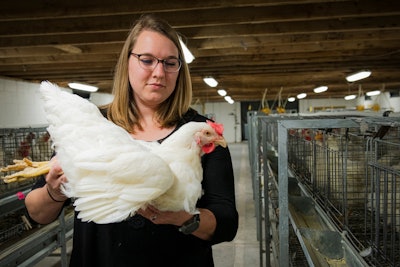
A specialty line of chickens bred for water conservation continued to gain weight even in conditions designed to induce heat stress, revealed new research published in Physiological Reports, the American Physiological Society’s scientific journal.
“Water scarcity will be an issue in the future,” explained Sami Dridi, poultry science professor at the Arkansas Agricultural Experiment Station, the research arm of the University of Arkansas System Division of Agriculture. “If we have a chicken that is more water efficient, I think we will save a lot of water.”
The line, now in its fifth generation, could help growers save money on water and feed without sacrifices to poultry health.
Positive results so far
According to the study, birds from the water-efficient line drank 1.3 pounds less water and consumed 5.7 ounces of less feed compared to chickens from the random-bred control line. These savings equate to a 32-point improvement in water conversion and a six-point improvement in feed conversion.
“One point three pounds may not seem like much for a single bird, but when you put it on the 9.22 billion birds produced, it could be a significant amount of water savings,” said Sarah Orlowski, associate professor of poultry science with the University of Arkansas System Division of Agriculture.
When exposed to conditions designed to induce heat stress, the findings were surprising. The heat-stressed birds from the water-efficient line consumed less water compared to non-heat stressed birds from a low water-efficient line.
“When you think of the genetic selection of the bird, water-efficiency-related traits haven’t really been included because there’s been a lot of uncertainty about if we select for water efficiency, what other traits are we going to impact?” Orlowski added.
“Now that we have these established models, we’re trying to figure out what else has changed? What else is different about these birds?”
Future study of the water-efficient chicken line will investigate any potential changes in meat quality and gut integrity.
The study is a part of a five-year multi-institution project to improve the efficiency of water and nutrient use in the poultry industry. The multi-institution comprehensive project includes research, teaching and extension components, brings together researchers from the Arkansas Agricultural Experiment Station, the research arm of the University of Arkansas System Division of Agriculture, and Cornell University along with five other universities.



















